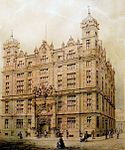Gustav Adolf Church, Liverpool
19th-century churches in the United KingdomBuildings by W. D. CaröeChurches completed in 1884Churches in LiverpoolGrade II* listed buildings in Liverpool ... and 2 more
Grade II* listed churches in MerseysideLutheran churches in the United Kingdom

Gustav Adolf Church (Swedish: Gustav Adolfs kyrka) or the Scandinavian Seamen's Church (Swedish: Skandinaviska sjömanskyrkan) is a historical building located in Park Lane, Liverpool, Merseyside, England. It consists of a church, built between 1883 and 1884, and an attached minister's house, and provides a centre for the Liverpool International Nordic Community. The combined church and minister's house is recorded in the National Heritage List for England as a designated Grade II* listed building.
Excerpt from the Wikipedia article Gustav Adolf Church, Liverpool (License: CC BY-SA 3.0, Authors, Images).Gustav Adolf Church, Liverpool
Park Lane, Liverpool Chinatown
Geographical coordinates (GPS) Address External links Nearby Places Show on map
Geographical coordinates (GPS)
| Latitude | Longitude |
|---|---|
| N 53.3996 ° | E -2.9844 ° |
Address
Gustaf Adolfs Kyrka
Park Lane
L1 8HG Liverpool, Chinatown
England, United Kingdom
Open on Google Maps







